

Immigration and Ethnicity: Overview - Theme - Electronic Encyclopedia of Gold in Australia. But perhaps the most significant population movement was the migration of thousands of people from overseas countries to the Victorian goldfields.

The influx led to dramatic changes in Victoria’s population, and more importantly, to its society and culture. This group of people is described as the ‘gold generation’, a generation that left a profound and lasting impact on the colony and on the Australian nation. Population growth The population of Victoria rapidly tripled as a result of the gold rushes, growing from 77,000 in 1851 to 237,000 in 1854. During 1852, the peak year of the rushes, 90,000 people arrived in Melbourne. The Australian gold rush. JCF Johnson, A Game of Euchre, col. wood engraving, Australasian Sketcher Supplement [Melbourne], 25 December, 1876.

Image courtesy of the National Library of Australia: nla.pic-an8927787. The gold rushes of the nineteenth century and the lives of those who worked the goldfields – known as 'diggers' – are etched into our national folklore. There is no doubt that the gold rushes had a huge effect on the Australian economy and our development as a nation. It is also true to say that those heady times had a profound impact on the national psyche. The camaraderie and 'mateship' that developed between diggers on the goldfields is still integral to how we – and others – perceive ourselves as Australians. Indeed, mateship and defiance of authority have been central to the way our history has been told.
Even today, nothing evokes more widespread national pride than groups of irreverent Aussie 'blokes' beating the English at cricket, or any other sport for that matter! Australian gold rush. The 1850s gold rush attracted many Chinese people to Australia in search of a fortune.
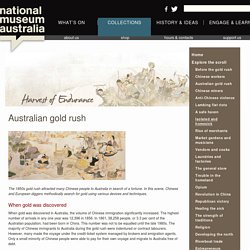
In this scene, Chinese and European diggers methodically search for gold using various devices and techniques. When gold was discovered. Australian Gold, History & Culture Info - Historic Gold Rush Village Mogo South Coast NSW Australia. Overview - Chinese People Living On 1800s Australian Goldfields - New South Wales.
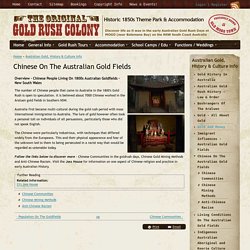
Www.scool.scholastic.com.au/schoolzone/toolkit/assets/pdfs/New_Gold_Mountain.pdf. Teaching writing with Christopher Cheng. Videos, Goldfields. Maldon Sample local wines and produce, or discover hidden treasures in one of the many antique stores.

Castlemaine Discover a fine goldrush heritage as you fossick for local arts, crafts and antiques. Bendigo. Teaching Challenges: New Gold Mountain #1. This week my literacy class started reading New Gold Mountain: The Diary of Shu Cheong by Christopher W.
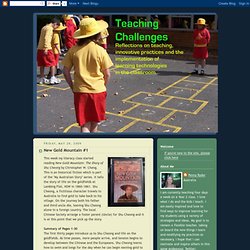
Cheng. This is an historical fiction which is part of the "My Australian Story" series. It tells the story of life on the goldfields at Lambing Flat, NSW in 1860-1861. Shu Cheong, a fictitious character travels to Australia to find gold to take back to his village. On the journey both his father and third uncle die, leaving Shu Cheong alone in a foreign country. Www.chrischeng.com/wp-content/uploads/2012/11/new-gold-mountain-uni-questions.pdf. Www.chrischeng.com/wp-content/uploads/2012/11/new-gold-mountain-teachers-notes.pdf. Christopher Cheng. Scholastic Australia 2005 ISBN 1865048518 Through the eyes of a Chinese boy Shu Cheong, we hear the story of life on the goldfields for the Chinese miners.
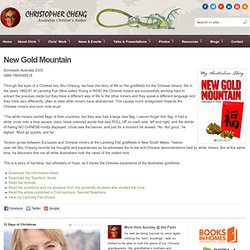
Set in the years 1860-61 at Lambing Flat (Now called Young in NSW) the Chinese miners are successfully working hard to extract the precious metal but they have a different way of life to the other miners and they speak a different language and they mine very differently, often at sites other miners have abandoned. This causes much antagonism towards the Chinese miners and soon riots erupt. “The white miners carried flags of their countries, but they also had a large new flag. I cannot forget that flag. Www.scool.scholastic.com.au/schoolzone/toolkit/New_Gold_Mountain.pdf. Websites for Reading Books & Stories online. Teaching Ideas. Future of Fiction. English Language Arts teachers are constantly fighting the battle to instil habits of reading and writing into learners who have so many other options of how to spend their leisure time.
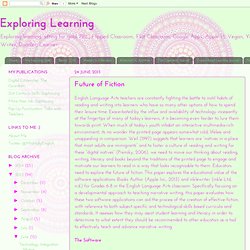
Exacerbated by the influx and availability of technology incessantly at the fingertips of many of today’s learners, it is becoming even harder to lure them towards print. When much of today’s youth inhabit an interactive multimedia-rich environment, its no wonder the printed page appears somewhat cold, lifeless and unappealing in comparison. Weil (1997) suggests that learners are “natives in a place that most adults are immigrants” and to foster a culture of reading and writing for these “digital natives” (Prensky, 2006), we need to move our thinking about reading, writing, literacy and books beyond the traditions of the printed page to engage and motivate our learners to read in a way that looks recognisable to them.
Pop-Up Punctuation Mini Project. Punctuation seems to cause a lot of problems for learners.
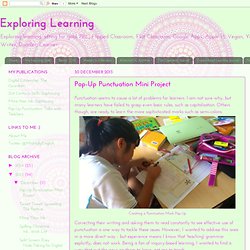
I am not sure why, but many learners have failed to grasp even basic rules, such as capitalisation. Others though, are ready to learn the more sophisticated marks such as semi-colons. Correcting their writing and asking them to read constantly to see effective use of punctuation is one way to tackle these issues. However, I wanted to address this area in a more direct way - but experience means I know that 'teaching' grammar explicitly, does not work.
Being a fan of inquiry-based learning, I wanted to find a way that put the onus on them to learn, not me to teach. I created and shared a Google Doc outlining the project, as follows:- S3 - Gold. Portals.studentnet.edu.au/literacy/uploads/goldngrammar_shoalhaven_unit.pdf. Into the Book: Teaching Reading Comprehension Strategies. The Story of Sliver Pete - from Children's Storybooks Online. By Carol Moore I've never told this story before, but just the same I'm telling you now.
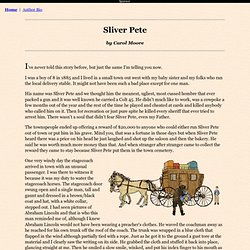
I was a boy of 8 in 1885 and I lived in a small town out west with my baby sister and my folks who ran the local delivery stable. It might not have been such a bad place except for one man. His name was Sliver Pete and we thought him the meanest, ugliest, most cussed hombre that ever packed a gun and it was well known he carried a Colt 45. He didn't much like to work, was a cowpoke a few months out of the year and the rest of the time he played and cheated at cards and killed anybody who called him on it. The townspeople ended up offering a reward of $20,000 to anyone who could either run Sliver Pete out of town or put him in his grave. One very windy day the stagecoach arrived in town with an unusual passenger. English - Get Smart.